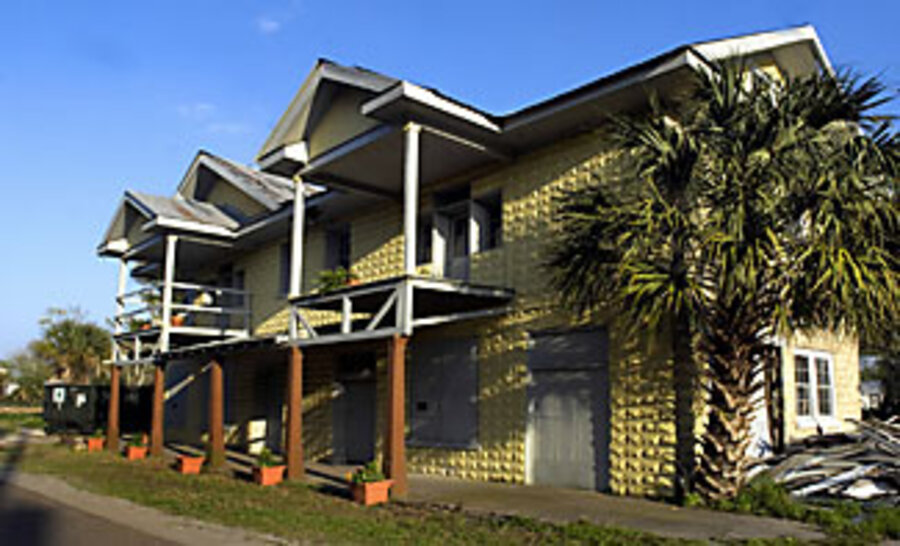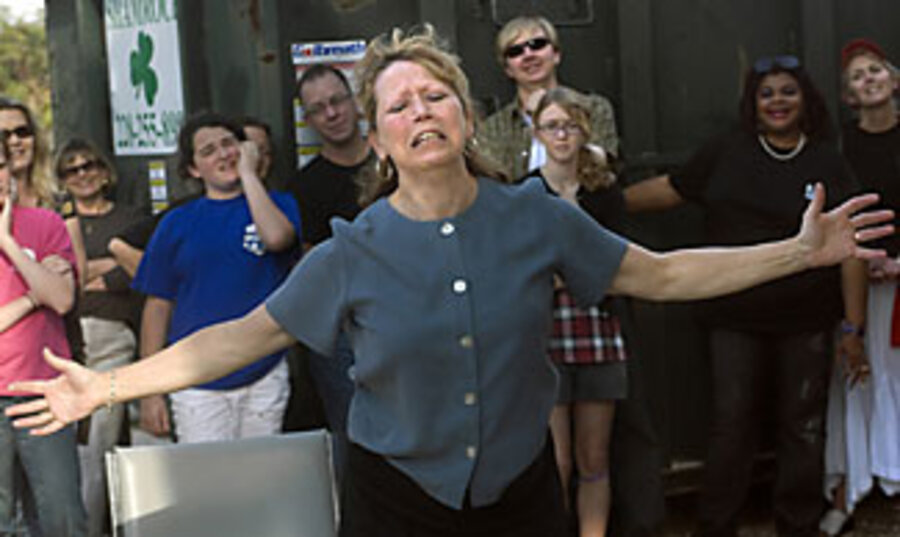One town uses the arts to revive after hurricane Katrina
Loading...
| Bay St. Louis, Miss.
The silence stretches long and languid as the sun sinks in the Mississippi sky, painting the crowd in slivers of gold. In the distance, a gull calls out across the Gulf of Mexico. A man steps forward and pauses, staring up at the curly-haired actress coquettishly smiling down from the balcony. He drops to his knees on the cracked sidewalk, throws his arms open, and screams: "Stellaaaaaaa!"
Then with a self-conscious grin, he leaps to his feet and makes way for the next "actor" to intone the famous line from a "Streetcar Named Desire," the play by Bay St. Louis favorite son Tennessee Williams, in the Stella-calling contest. On the contestant's black T-shirt, three white letters catch the eye: B.L.T. – Bay St. Louis Little Theater. To his left, a tin sign leans against the yellow building, spray-painted words underscoring the greater meaning of today's light-hearted event: The show must go on.
Hurricane Katrina drew the curtains on the theater, as well as on Bay St. Louis, two and a half years ago. But the arts community refused to let the lights dim, and today they're helping revive a town in one of the rare success stories of post-Katrina life on the Gulf Coast.
Across the region, the hurricane's imprint continues to be as somber as an Edvard Munch painting: damaged downtowns, destroyed neighborhoods, FEMA trailers serving – seemingly endlessly – as homes. But here in Bay St. Louis (pop. 8,000), arts mavens and tourists are returning, and homes and businesses are being rebuilt, helping to resurrect the economy and sharpen the community's identity as a cultural hub.
The town, admittedly, has an advantage over many other communities along the Gulf Coast. Even before Katrina, it was a vibrant center for tourism and the arts – a Santa Fe of the South. Yet now artists from across the country are sending money and aid, which, along with infusions of federal cash, are helping the once-sleepy fishing village further reinvent itself and raising a provocative question: Can the arts rescue a town?
• • •
As you drive along the town's main drag – a scant five miles – its raison d'être is apparent. Two towering columns on the newly constructed Bay St. Louis Bridge greet drivers, each featuring intricate etchings of shrimp boats and other scenes, supplemented by 22 mile markers bearing brass plaques with local artwork. The county hospital showcases hundreds of other pieces of art. The post office bears a historic mural. The library is stuffed with paintings and sculptures.
"I don't know of another place more diverse in the arts," says Gwen Impson, former president of The Arts, Hancock County, a group supporting more than 200 artists ranging from belly dancers to poets. "Art is more than decoration; it's the soul of the community."
That soul became crucial after Katrina. In a maelstrom of chaos, it provided comfort, direction, and cheer. There was no power, no phones. Artists were scattered across the country, their supplies gone, their galleries in ruins. Groups gathered on street corners, staging art shows by candlelight. But few buyers were thinking of anything beyond the day at hand. The nation's eyes were focused on New Orleans.
As the smaller towns pondered whether to rebuild at all, the Bay St. Louis arts community hit the phones and computers, searching for artists and supplies. They asked galleries from New York to Los Angeles to exhibit their work. And everywhere they went, they put out the word: We're still here. Come to Bay St. Louis. Come home.
Anita Gallagher, a watercolorist and printmaker, lost her home and studio in Katrina. She fled to nearby Ocean Springs. A grant from the National Endowment for the Arts and donations from artists nationwide helped her survive. Eventually, she and other local artists landed a showing at the Clinton Presidential Library in Little Rock, Ark. "Some of these artists were having to work morning, noon, and night so they'd have money to rebuild," says Ms. Gallagher. "Little Rock was a big jumping point for them because they got national recognition."
Other artists changed their styles. Lori Gordon was primarily a landscape painter before the storm. Afterward, faced with no supplies, only the battery-powered screwdriver her husband had escaped with, she started producing mixed-media artwork. She used refuse from the beach in her pieces. Suddenly, her work was showing in Seattle, New York, and San Francisco – and hanging on the walls of singer Faith Hill and former president Jimmy Carter.
"Katrina opened doors all over the country that wouldn't have been open to me otherwise," she says. "As difficult as Katrina was, and still is, it brought some really wonderful things not only to my life, but to others."
Beth Carriere, executive director of Hancock County's Tourism Bureau, believes the arts community is stronger now than it was before the hurricane because members are more tightly knit and well-known. City clerk Buz Olsen says this new recognition and income, along with federal and state funding – $300 million so far – has brought Bay St. Louis to 70 percent full recovery. Virtually every business in the city – more than 300 retail shops, restaurants, gas stations – were damaged or destroyed. But most have rebuilt. Life is slowly returning to normal.
"The arts community is changing the perception of our area," Ms. Carriere says. "We're not just a beach resort, or a historic fishing village, or a casino town. We're all of these things, plus the arts."
Beyond holding Bay St. Louis together, culture also bonds its people. Restaurant owner Steve d'Angelo says he quickly saw the role art could play in boosting spirits and rebirth. Though his business, Bay City Grille, was heavily damaged, he knew people needed laughter even more than nourishment. So he invited actors from the Bay St. Louis Little Theater to perform "You're a Good Man, Charlie Brown" to local patrons.
"We were just starting to serve food again, and emotions were high on all sides," Mr. d'Angelo recalls. "Everybody was still lining up for water. That show was the first sign of life, and people needed that – a familiar place with a familiar scent – to begin healing."
• • •
Rosemary Migliore slaps a maroon cap on her head as she approaches the balcony. "Stellaaaa!" Ms. Migliore calls, weeping as she throws herself to the ground in front of the century-old ivy-choked building that is the theater's new home. Katrina ripped the roof from the building the theater had been using, flooding the interior and leaving it uninhabitable.
Now, thanks to state grants and the efforts of cast members, a new home is rising from the ruins. Inside, the two-story structure doesn't look like much yet. The floors are plywood, the walls exposed studs. Cast members spent three whirlwind weeks removing debris from the building, which had stood vacant 40 years.
Theater president Cheryl Grace says it will take two years and close to $1 million to complete repairs. Meanwhile, they're holding outdoor shows and dragging folding chairs inside to keep the stage alive. "When the theater was destroyed, I knew in essence it wasn't, because we had all our memories," says Ms. Migliore. "We had such great fun there. But it was only a building. The spirit was still alive."
In 1946, Tennessee Williams settled in Bay St. Louis and wrote, appropriately, a one-act play, "This Property Is Condemned." Twenty years later, Robert Redford and Natalie Wood came to do a movie version of the work. After Katrina unleashed her fury, no one could have guessed where Bay St. Louis would end up. But these days, no one's dwelling on the past. There are canvases to be filled, clay to be shaped, plays to be performed. An entire city is restless. The show must go on.






